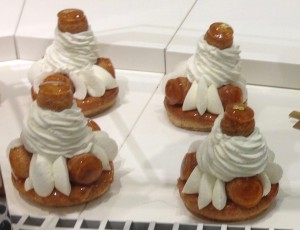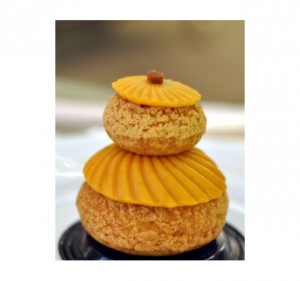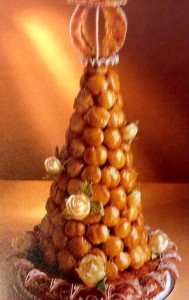English is a confusing language even for native speakers. We are criticised for failing to learn other languages.
Even with the best of teachers French can cause as much confusion as English. This entry is headed Choux. Will we be discussing cabbage and its versatility, or pastry, also versatile with numerous uses both sweet and savoury?
Leaving cabbage for later this entry introduces choux pastry with a recipe for ‘chouquettes’, small balls of choux pastry, often sprinkled with candied sugar and found for sale in almost all patisseries in France. Master the art of chouquettes and you have all the necessary knowledge to create a wealth of other choux pastry based products including éclairs, religieux, glands (so called because they are meant to resemble acorns, for which the French word is gland) and the impressive pièces montées central to many wedding banquets.
Curious about the history? Read on….
History
It is likely that you will have come across choux pastry whether you have known it or not. Most English bakery shops sell éclairs. Many restaurants serve profiteroles. French patisseries also sell numerous cakes based on choux pastry including their interpretation on eclairs and other common delights such as the religieuse, the divorce, the gland and of course the ubiquitous chouquette. The gland is usually decorated with green icing because it is supposed to resemble an acorn. Those who concentrated more than me in their French class at school might not have needed to look that up.
The Saint-Honoré is a slightly more elegant pastry than many of those listed above:

Christophe Michelak, one of the better known French Pâtissiers of today, has taken the well known religieuse, two choux buns, one larger than the other, usually filled with chocolate or coffee flavoured creme patissiere, and transformed it into one of his signature desserts at the Hotel Plaza Athene in Paris. 
A little research quickly indicates that choux based cakes are another import from Italy. It seems they were introduced to France by Catherine de Medici. While not called ‘choux’ at this time the name evolved as a result of the irregular shape of the little cakes, thought to resemble a cabbage.
The excellent Food and Cooking (McGee 2004) advises that choux pastry dates from medieval times and is characterised by being cooked twice: in the early stage when the paste is prepared and then when it has been formed into whichever final product has been chosen when it is baked or fried. Choux pastries were sufficiently established in 17th century France to be recorded in a French English dictionary of 1611. Petits choux, shortened to tichoux was a street cry of vendors selling small cakes of egg and flour with butter and sometimes cheese. Savoury chouquettes are known as gougères or, if deep fried, as a form of beignet.
Alexandre Dumas (1873) described choux pastry as excellent, comprising a little water, butter and salt to which are added a handful of flour….
It seems that cooks in the nineteenth century were used to such imprecision in their recipes. In the twenty-first century those of us interested in patisserie are told over and over that precision is vital if we are to succeed, we delight in our electronic scales capable of weighing fractions of grams hoping that so armed we will be able to reproduce the pastries we see in the windows of the best patisseries.
For a recipe to survive largely unchanged from medieval times it must have something about it. Choux pastry creates cakes, whatever their final shape, that are hard on the outside with a cavity inside that can be filled with any number of different fillings. No doubt this explains the longevity of the recipe – pastries that can be filled with almost anything and which are easily transported.
Some Science
McGee’s book gives us science as well as some history for the things we bake. He describes choux pastry as a brilliant invention in giving a cook a means to produce a hollow, crisp vessel for other ingredients. This comes about because we cook the flour with the water or milk and butter, tenderising the gluten proteins and preventing them from developing elasticity. As a result ingredients that might otherwise have formed a batter (if beaten together cold) instead form a dough. Eggs bring richness from the yolks and structure building proteins from the whites. Adding egg thins the dough so that air pockets will be able to move and coalesce with the heat of cooking. The butter contributes towards a baked product that resists moisture and stays crisp when holding a cream filling. (p553)
In theory.
Despite choux pastries existing for centuries today’s cookery writers appear unable to agree as to a definitive recipe. Some use milk while others use water instead. Others use water but add powdered milk.
The strength of choux pastries and their ability to keep their form when filled with cream is not perfectly reliable. Like many pastries choux products exposed to air will soften in time. Viewers of both English and French versions of a popular televised baking competition have seen contestants struggle to create a Religieuse à l’Ancienne, a variation of the pièce montée central to many family celebrations.
In France the attempts were so disastrous that no scores were allocated for that task. The incredible Mercotte (France’s answer to Mary Berry) sets out fully detailed instructions for this recipe in her Blog. This picture illustrates what the candidates were attempting to create.
Personally I think I would rather create the more traditional pièce montée based on chouquettes and nougatine than this recipe.
The problem in both competitions was the failure of the filled pastries to maintain their crispness, and so their strength, once filled with cream. Chouquette versions are easier to build because each cake is small and they are generally constructed with caramel to cement the pieces together.
 A recipe for a Croquembouche, the traditional choux bun tower, is included in The Roux Brothers on Patisserie written by Albert and Michel Roux in 1986 and one of the best introductions to patisserie we have found. The book is still available via Amazon.
A recipe for a Croquembouche, the traditional choux bun tower, is included in The Roux Brothers on Patisserie written by Albert and Michel Roux in 1986 and one of the best introductions to patisserie we have found. The book is still available via Amazon.
Paris has numerous shops that only sell macarons in many varieties. Pierre Hermé has done particularly well with his macarons although of course he does make other excellent products. Others, having seen the success of single product shops have searched for their ‘macaron’: a simple item, easily varied. Christophe Adam has done this with éclairs. People from all around the world will find time to call at one of his shops during their visit to Paris. Mr Adam now has three shops in Japan where French patisserie is hugely popular. Adam’s eclairs come in all flavours imaginable, he uses both centre and top to hold his various embellishments. Interviewed recently Mr Adam expressed confidence in the longevity of his mono product concept, following in the tradition established decades earlier by chocolatiers. Personally I’m not entirely convinced that an eclair, however beautifully made and garnished, can compete with artisan chocolate.
As with macarons it is easy to produce a basic eclair. Once you have mastered choux pastry it is only imagination that limits the variations possible.
Recipes
Most of the ingredients necessary for our recipes can be found in high street shops. Others are easily found on-line in specialist patisserie suppliers. We are not paid to promote any shop or supplier but in view of the difficulties we have encountered from time to time when sourcing some products we include a list here of suppliers we have found useful.
Baking individual chouquettes, éclairs or any of the other choux based products found in patisseries today is not difficult. There are however numerous variations on the basic choux pastry recipe. My first successful attempt was achieved with the help of a blog called ‘Oh la vache’. Sadly the blog is no longer available but it’s author, Luca Marchiori, has moved from France to Italy from where he has launched a new and equally interesting project: ‘Chestnuts and Truffles‘ detailing the best of Italian cuisine and culture.
The following recipe can be used to make a first small batch of chouquettes. It is an ideal starting point as it introduces the key techniques demanding only a small amount of ingredients.
Chouquettes
50g water
50g milk
2g sugar
44g salted butter
56g plain flour
100g eggs
Candied sugar to decorate
Some notes before getting started
Method
These small choux pieces have numerous uses. They can carry sweet or savoury fillings, they form the base of profiteroles and, joined together, they can become the base of a cream filled dessert along the lines of a St Honoré.
Here is a recipe for a ganache filling that can transform basic chouquettes. It can also serve as a filling for macarons and eclairs. Much, much more to follow on chocolate.
Ganache
Some notes before getting started:
You will need:
110g milk
25g single cream
235g chocolate (couverture)
45g butter at room temperature
To make the ganache
Assembly
Using a small piping nozzle or the point of a small knife gently pierce a hole to the underside of each chouquette.
If your ganache has been stored in a bowl you will need to transfer it to a piping bag fitted with a nozzle small enough to fit into the holes in the base of the chouquettes.
Gently pipe ganache into each chouquette,
Enjoy!
References:
McGee H (2004) McGee on Food and Cooking, Hodder & Stoughton UK
Roux, Michel & Albert (1986) The Roux Brothers on Patisserie, MacDonald & Co. London
Davidson, A (2006) The Oxford Companion to Food 2nd Edition, Oxford University Press.
Beeton I (1861) The Book of Household Management (released as eBook by Project Gutenberg 2003)
Dumas A (1781 ) Grand Dictionnaire de Cuisine, Paris (available via Google Book Search)